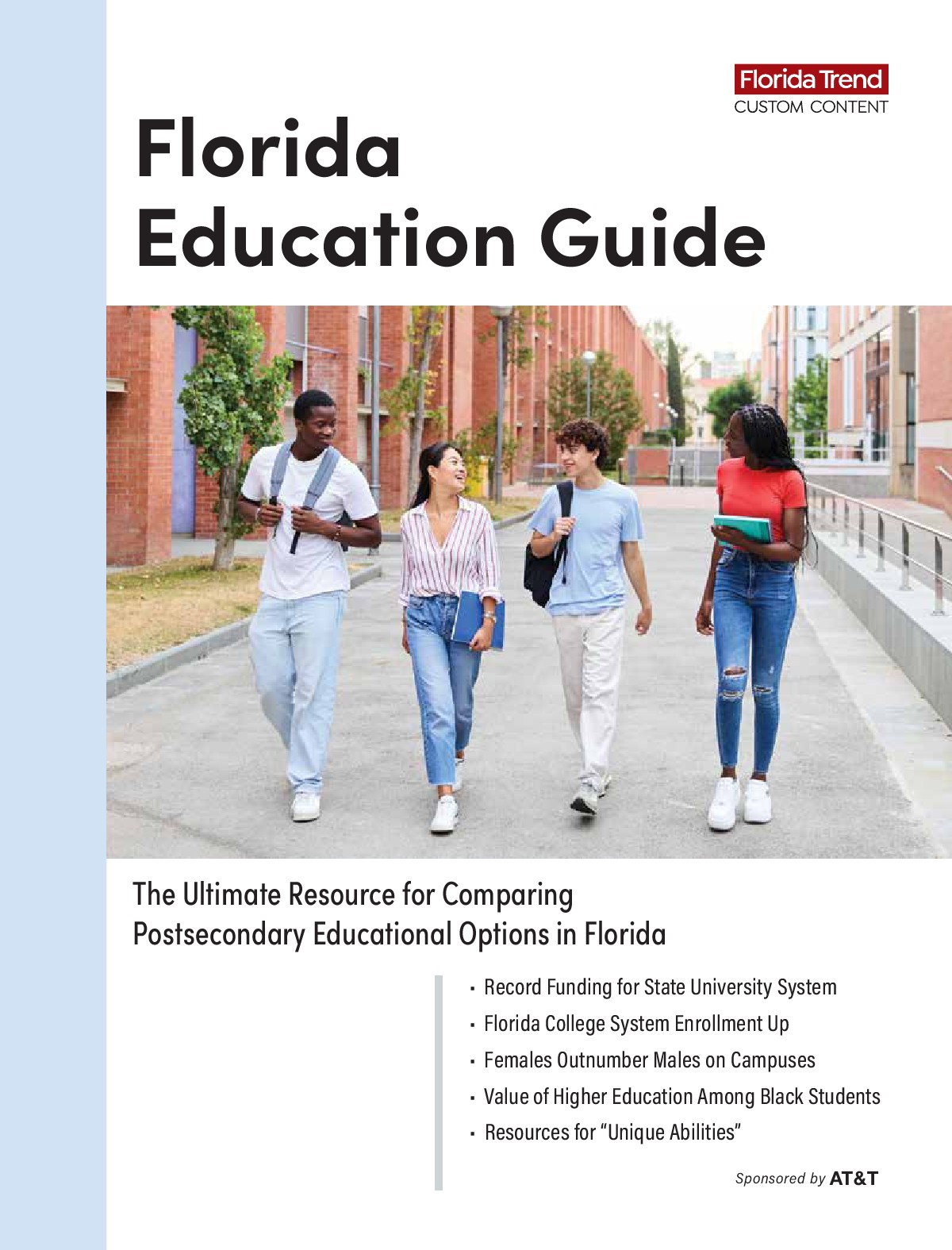 "We're not Chicken Little worried about the sky falling. We're moving ahead," says FIU President Mark Rosenberg, formerly chancellor of the State University System. [Photo: Roldan Torres-Moure] |
In 2006-07, Florida's universities spent a total of $12,011 on each full-time student. More than three-quarters of that sum came from the state's general fund and other state money — the Bright Futures scholarship program, the Florida Lottery and various trust funds. Parents and students, for their part, paid 21% of the total bill in tuition.
Beginning in 2007, however, the Legislature began shifting more of the funding burden to students and their families. Lawmakers loosened the leash on what the schools can charge for tuition and since 2007 have cut base funding for the universities by $654 million.
By 2009-10, overall spending had fallen to around $11,000 per student, with an additional $500 from now-vanished federal stimulus money. More notable was the shift in where the money came from: Students and parents were paying 29% of the total in tuition. That percentage likely will be higher when figures for the most recent academic year are available.
This wrenching shift for schools and families will become more pronounced in years to come. Few expect the Legislature to restore the base level of state support to its previous share of the total. Meanwhile, the universities can increase tuition up to 15% each year until they hit the national average — which will take nine years, officials estimate — or until they start losing students to state (community) colleges, private and out-of-state schools.
In addition, since the burden-shifting hasn't produced any net increase in funding for the schools, Florida still ranks about where it did before in per-student spending — by various measures, among the bottom 10 states.
And so to get the money they say they need to get better, Florida's schools will be looking to drive revenue.
| Graduation Rates | |||
| (for first-time-in-college undergrads graduating within six years at State University System schools) | |||
| ? | Enrollment | 2000-06 | 2004-10 |
| UF | 50,116 | 7 9% | 83.0% |
| FSU | 40,764 | 67.2 | 72.4 |
| New College | 805 | 56.7* | 68.3 |
| UCF | 56,338 | 56.5 | 62.7 |
| USF | 47,800 | 46.3 | 50.7 |
| UWF | 11,645 | 44.3 | 50.6 |
| UNF | 16,320 | 44.3 | 45.4 |
| FGCU | 12,038 | 32.4 | 44.8 |
| FIU | 44,010 | 45.4 | 43.5 |
| FAU | 28,390 | 35.3 | 40.2 |
| FAMU | 13,277 | 41.7 | 39.6 |
| Systemwide | 321,503 | 62.3 | 63.3 |
| Note: New College was not a stand-alone institution in 2000. Its 56.7% rate is for 2001-07. Source: Florida Board of Governors | |||
» GET THE FULL LIST: |
|||
To control its destiny, FIU expects to continue raising tuition and projects adding some 20,000 students over 10 years, which would make it bigger than Florida's largest university, the University of Central Florida, is now.
"It's forward-facing; it's aggressive," says FIU President Mark Rosenberg, formerly chancellor of the State University System.
Shrinking state support for public universities is a nationwide trend, as Medicaid and other entitlements along with rising public employee pension and healthcare costs force states to cut discretionary parts of their budgets, says higher education financial consultant John Curry, managing director of Huron Consulting Group in Boston.
A decade ago, public universities in America got 70% of their revenue from state appropriations, with the remainder coming from tuition. Today, they get 70% from tuition and the remainder from their states.
Nationally, universities have cut staff and slowed construction plans, but the outlook remains tough for all but the best-regarded private universities and public flagships as donors retreat, states cut spending and parents with falling incomes resist rising tuition, according to bond rating agency Moody's.
Public universities, meanwhile, face increasing competition from community colleges and for-profits that offer flexible schedules.
"Reliance on government appropriations has declined over the past five years as public universities have become increasingly market-driven, and we expect this trend to continue," Moody's reported in its 2011 outlook for higher education.
Against that backdrop, Florida has pluses. Like most southern and western states, it has superior growth demographics. To a degree, the Legislature has given its schools more leeway to pursue market-driven initiatives.
Among the revenue sources Florida universities are pursuing:
» More foreign and out-of-state students
Florida wants more out-of-state students in part because they pay more. At a typical Florida campus, an out-of-state student pays $10,000 more each year than a student from Florida.
| Where Do They Go after High School? |
|
|
| Note: Numbers total more than 100% because students may enroll in more than one sector. Source: Florida Board of Governors |
But every state has the same idea. At Florida's public universities, out-of-state student revenue has actually fallen from $192 million four years ago to $176.5 million in 2010-11, according to Florida Board of Governors data. Curry, the higher education consultant, drew chuckles at an administrators conference earlier this year with his observation: "State X has all of its students coming from State Y and State Y has all of its students coming from State X. Is that how you're going to solve the problem?" he asks. "That maybe works for some universities, but it certainly won't work for all of them" [Overseas Subsidy].
» Research
Rosenberg echoes every Florida university administrator in saying FIU will be "more aggressive" in going after federal research dollars. He wants to increase research revenue 39% to $146 million by 2015-16. Research grants build prestige, bring a professor extra salary, fund graduate students, pay for expensive lab gear and provide research opportunities for students that help them learn and get jobs — plus help solve community problems or societal ills and disease.
Getting outside funding to pay for all that saves universities money but otherwise, research doesn't help the bottom line. Federal grants cover the cost of doing the research and provide "overhead" money — but that just compensates universities for the costs of compliance and similar administrative costs. State and private donors rarely do even that much. In shell-game fashion, some universities reinvest that overhead in developing new grants. Research dollars at Florida's public universities increased 143% since 2000 to $1.7 billion.
?
 This month, Florida universities for the first time will have the freedom to charge real market rates for some online graduate programs. [Photo: Florida International University] |
What research does offer is the hope of a commercialization home run. "The stories about Gatorade at the University of Florida and (anti-cancer drug) Taxol at Florida State University are legendary," says University of South Florida provost Ralph Wilcox, which has received a $60-million licensing fee for a promising anti-depression drug now in trials. "We have high hopes."
» Donations
| Well Heeled | ||
| Florida's Top 20 Endowments | ||
| 1. |
University of Florida |
$1.1 billion |
| 2. |
University of Miami | 618 million |
| 3. |
Florida State University | 453 million |
| 4. |
Miami Dade College | 306 million |
| 5. |
University of South Florida | 296 million |
| 6. |
Rollins College | 280 million |
| 7. |
Florida Atlantic University | 156 million |
| 8. |
Stetson University | 123 million |
| 9. |
University of Central Florida | 103 million |
| 10. |
Florida A&M University | 96 million |
| 11. |
Florida International University |
95 million |
| 12. |
University of North Florida | 69 million |
| 13. |
Embry-Riddle Aeronautical University | 64 million |
| 14. |
Valencia Community College | 63 million |
| 15. |
Broward College | 62 million |
| 16. |
Palm Beach Atlantic University | 61 million |
| 17. |
Florida Southern College | 52 million |
| 18. |
University of West Florida | 50 million |
| 19. |
Florida Institute of Technology | 45 million |
| 20. | College of Central Florida | 40 million |
| Source: Chronicle of Higher Education Endowments 2009-10. Amounts have been rounded. | ||
» Partnerships
FIU gets revenue from a partnership with Florida Power & Light, which rents a small space on campus for a call center staffed by student interns looking to get experience and a leg up for management jobs after graduating. It plans to partner with other south Florida organizations.
» Market-rate grad programs
Grad students pay more. This month, armed with new authorization from the Legislature, Florida universities begin offering some online graduate programs free of state strictures that restricted price to what it cost the school to offer the program. How much pricing power universities have depends on the strength of the brand. Other Florida universities look longingly at UF's online MBA programs, the best in the world in some rankings, as a brand with pricing power. The price for its one-year professional MBA program is increasing 11.8% to $36,000. By pricing five programs at market rates, UF hopes to see a 9% revenue increase. Those programs at present bring in $26.5 million.
» New markets via online
Most Florida universities want to do more online. Online classes allow them to reach new markets geographically or demographically that would be too costly to serve with satellite campuses or with traditional classes. Some 7.3 million of the nation's 19 million students in the higher education market are over age 25. Since 1993, UF has been contracting with Embanet-Compass Knowledge, a company based in Chicago and Orlando that helps universities offer advanced degree programs online. The two split revenue (starting at 60% to Embanet Compass and going down as revenue rises).
Online is a big market for Florida universities, though hard to quantify. State data count classes offered online to students living 200 feet from campus along with classes for students living 200 miles from campus. That said, just over half of Florida public university students — 172,000 — took a class in 2009 in which more than 50% of instruction was delivered by technology. Some 26,024 — equivalent to the student body of one of Florida's smaller universities — took only online classes, UCF is the leader in courses and enrollments, followed closely by USF and UF. » Enrollment growth
The universities' need for more paying customers dovetails with demand from Floridians for slots and President Obama's goal of increasing America's degree holders. The University of North Florida, for example, wants to add 8,000 students in 10 years to get to 25,000. FAU wants to grow from its current 28,000 students to between 33,000 and 35,000. Even growth-averse UF is trying to increase its capacity by creating a spring-summer college career, a period when exiting December graduates leave room for newcomers. "To our knowledge, no one has done this," says provost Joe Glover.
» Higher tuition
As numbers rise, so will tuition. The Legislature in 2007 joined a few other states that recently gave universities more latitude in setting their own prices: Each year, the Florida schools can add to whatever systemwide increase the Legislature enacts, up to a 15% increase. They can keep raising tuition each year until they reach the national average.
 To most efficiently use higher-ed dollars, "the single most important action we can take is to improve our retention and graduation rates." — Mark Workman, provost, University of North Florida |
The differential, which is cumulative, has raised $115.7 million in the last two years for universities. UF President Bernard Machen and FSU President Eric Barron this year unsuccessfully sought permission to raise their tuition 30%, and there's sentiment among some higher ed leaders that UF and FSU, as the state's strongest brands, should be completely free to set their tuition at market rates.
UF, additionally, wants permission for block tuition, in which students pay a flat fee per semester for their classes rather than by the credit hour. The main point, Glover says, is to increase access to UF by having existing students graduate faster, but it also will bring in $3 million to $4 million a year in extra revenue.
Rosenberg says FIU's projection for higher tuition and enrollment growth over 10 years will mean funds for 900 new faculty at an institution where faculty is "stretched thin," reducing its student-teacher ratio to 24:1 from 27:1. The projection also calls for more advisers, putting FIU in the national range for advisers- per-student.
"This growth model is about how to have a better institution," Rosenberg says. "We're going to try to take charge of our future through this growth."
Tuition Timeline
A coming lesson in price elasticity of demand.
Economics homework assignment: As Florida public universities jack up tuition by 15% per year, how long before price-anxious students switch to state colleges or private universities? State college degrees are cheaper; you can live at home. Private universities argue that they offer superior quality and can have such generous aid that they can be price-competitive.
 In 2007, the Legislature freed public universities to raise tuition up to 15% per year until they hit the national average. At Florida Trend's request, the Board of Governors calculated that will take nine years. (This assumes 15% annual increases in Florida tuition and 5% increases in fees and 7.1% annual increases in the national average — the average for the last five years.)
In 2007, the Legislature freed public universities to raise tuition up to 15% per year until they hit the national average. At Florida Trend's request, the Board of Governors calculated that will take nine years. (This assumes 15% annual increases in Florida tuition and 5% increases in fees and 7.1% annual increases in the national average — the average for the last five years.)
So come 2019-20, today's Florida third-graders could be spending exactly the same as the projected national average of $14,100 — a 189% increase from the past year.
Florida administrators, pointing to rising applicant numbers and quality, say there's no sign of higher tuition driving off students. They say they're sensitive to the impact of 15% annual increases but argue the current base is so low — 48th nationally — that there's plenty of headroom.
"The cost of a Florida education is still a huge bargain," says University of North Florida provost Mark Workman.
All schools likely won't arrive at the national average simultaneously. Most expect the schools most in demand — UF and FSU, for example — to increase tuition by the maximum allowable percentage each year until they reach the national average. Smaller schools likely will get there more slowly, finding resistance from prospective students.
Administrators also anticipate other impacts beyond their top lines. "As students and their parents pay higher tuition, the expectation of services and support rise significantly because they see themselves more as customers and consumers rather than students subsidized by the state," says University of South Florida provost Ralph Wilcox. "That's a phenomenon public universities are going to have to deal with."
| Educational Bargain | |||
| Tuition and fees at Florida universities are far below the national average. A sampling of school tuition and fees: | |||
University |
Tuition / Fees | Room / Board | Total |
| Arizona State University |
$9,720 | $11,436 | $21,156 |
| University of Virginia |
$11,794 | $9,036 | $20,830 |
| University of Georgia |
$9,472 | $8,708 | $18,180 |
| University of North Carolina - Chapel Hill | $7,008 | $9,470 | $16,478 |
| University of Florida |
$5,700 | $8,800 | $14,500 |
| Florida Gulf Coast University |
$5,352 | $9,201 | $14,553 |
| University of Central Florida | $4,518 | $8,574 | $13,092 |
Overseas Subsidy
International students bring to Florida universities a global view — and pay full-freight tuition prices.
 Florida universities will be looking more to foreign students such as Yue Wang, who graduated from FIU in May, to make up for cuts in state support. [Photo: Donna Victor] |
In 2009, as Yue Wang, a young college graduate in the Chinese coastal city of Tianjin, contemplated where she would like to study abroad for her master's, her attention turned to a billboard in the city advertising Florida International University.
Other signs began to point to Florida. Her uncle knew a student in FIU's hospitality program who liked it. A 2007 film adaptation of "Miami Vice," featuring Chinese actress Gong Li, left a favorable impression of Miami. Wang went to her college teacher. "I still remember his words. 'If you could get the admission letter from the university, it will change your life.' "
Wang, 25, graduated in May from FIU with a master's in Asian studies. She says living in the United States indeed changed her life.
| By the Numbers | |
| 29,708 Number of foreigners studying at Florida colleges and universities in 2009-10 | |
| $827 million Amount spent in tuition, fees, room and board by foreigners at Florida's public and private universities | |
| 6th Florida's rank nationally in number of foreign students, with India, China, Venezuela, South Korea and Colombia sending the most | |
| Source: Institute of International Education and the Association of International Educators |
Florida universities are looking for foreign students to change theirs. All the universities are quick to say foreign students bring a global viewpoint that enhances the education of Florida students. Foreign students also tend to be the best of their country's lot — hardworking, smart, excelling in math, engineering and the sciences, a good resource for Florida in the global talent wars.
But the schools also aren't shy about pursuing the incremental dollars that foreign students bring. Revenue from out-of-staters has fallen by some $16 million since 2007-08, but Florida's universities are aiming to reverse that trend. By 2015, FIU wants to increase its share of out-of-state and international students to 12%. A back-of-the-envelope calculation, taking into account FIU's plans for significant overall enrollment growth, puts the incremental revenue around $24 million a year. That buys a lot of professors.
Florida has a 10% systemwide cap on non-Florida students. In recent years, the number of non-Florida students has been dropping. Currently about 8.7% of public university students are from outside Florida. The difference between 8.7% and 10% works out to $43 million in missed incremental revenue, assuming non-Floridians pay $10,000 more per year than in-state students.
| Revenue from Out-of-State Students |
|
| (Including both U.S. and international students at Florida's public universities) | |
| 2006-07 | $190.3 million |
| 2007-08 | 192.2 million |
| 2008-09 | 188.3 million |
| 2009-10 | 188.5 million |
| 2010-11 | 176.5 million |
| Source: Florida Board of Governors | |
"USF, as we speak, is getting promoted 24/7 in 75 countries all around the world," says David Stremba, INTO's managing director for North America. INTO spends $12 million on marketing and for in-country recruiters for 10 universities in the U.K. and USF and Oregon State University.
In fall 2010, 460 students enrolled in INTO USF, beating projections by 39%. In a semester-long, INTO USF program run by USF, students improve their English while taking "pathway" academic classes and receive mentoring in studies and the transition to life in the States. (International students, for example, have to learn that it's fine here to raise a hand to interrupt a professor in mid-lecture to get a point clarified.)
Some 93% of the students in the 2010 class were eligible to progress to the university, paying full freight. The program has created more than 50 jobs. More than 700 more students begin the program in August. "It's been immensely successful," says USF provost Ralph Wilcox. "The early returns have far exceeded our most ambitious projections. We expect it will yield some pretty significant revenues."
After USF recovers the cost of educating the students in the program, it splits the surplus with INTO and, of course, gets all the revenue from students who matriculate into the university.
The program widens the pool of available international students, for which "competition is incredibly fierce," Stremba says. And satisfied students build word-of-mouth marketing in their home countries. "It's worth it to spend that money at the University of South Florida," says Hao Wang, a 24-year-old from Nanning, China, who successfully completed the INTO program and now is pursuing a master's in finance. He says he is gaining the American perspective and exposure to American culture he thinks will benefit his career.
Pandu Swaraga, 25, of Indonesia, says his employer, PT Petrokimia Gresik, fulfilled his lifelong wish of seeing American when it sent him to the program. "It really is a dream come true." He's now pursuing a master's in finance.
Yue Wang, meanwhile, is getting another kind of education: Trying to find a job for the year her visa allows her to work in the United States.
Edifice Complex?
 FAU's new football stadium was funded in part through bonds tied to athletic fees. [Photo: Florida Atlantic University] |
Parents and other observers may be forgiven if they see a disconnect: Come August, even as administrators decry a drop in taxpayer support, Florida Atlantic University will open housing for 1,200 more students and a 30,000-seat football stadium in Boca Raton. New university buildings are sprouting all over Florida campuses. There's so much building at UCF that some joke the school's initials could stand for Under Construction Forever.
So how can universities bemoan a lack of taxpayer support, shut down programs and cut faculty while spending millions to pour miles of concrete?
The answer is separate pots of money that keep buildings rising even as money for operations falls. Housing and other auxiliary departments such as parking are self-supporting. If a university convinces bond buyers it can fill a dorm with enough paying students to support operations and debt service, it can borrow to build.
Some campus construction is funded by donations specifically made for a building. But the deep well universities draw from to pay for classroom buildings is Florida's great innovation in financing education, a dedicated construction-only funding source. Called the Public Education Capital Outlay (PECO), it is funded by a gross utilities receipt tax on everything from trash collection to phone service. K-12 schools get 70% of the haul. State (community) colleges and the universities each take 15%. The universities have spent $3.5 billion in PECO money since 2000, according to the state Board of Governors. Changing the law so that the money could go to operations has been a non-issue — the topic hasn't been raised.
Stadiums? FAU's new one was partly financed by bonding a piece of student-paid athletic fees with the rest to be funded by naming rights, concessions, ticket sales and parking revenue. It's "not through state dollars," says Dennis Crudele, FAU senior vice president for financial affairs.
| Operations: In the Red | ||
| Each year since 2007-08, the Legislature has reduced base funding for Florida's public universities. | ||
| Year | Reduction in Base Funding (in millions) |
Base Total (in billions) |
| 2007-08 | -$95.2 | $1.91 |
| 2008-09 | -129.6 | $1.78 |
| 2009-10 | -278.1 | $1.50 |
| 2010-11 | -36.6 | $1.47 |
| 2011-12 | -114.4 | $1.35 |
| Building: In the Black | |
| Total building-related funding, including matching funds from general revenue. | |
| Year | Funding for Buildings (in millions) |
| 2007-08 | $702.7 |
| 2008-09 | 576.7 |
| 2009-10 | 130.5 |
| 2010-11 | 311.1 |
| Source: Florida Board of Governors | |
Banner Years for Private Schools
Talk about the effects of the recession and today's anemic economy with the leaders of tuition-dependent private schools like Florida Southern College, Eckerd College and Barry University, and the response is pretty much a collective shrug.
 Students at Florida Southern College in Lakeland. "We've had banner fundraising years," says Florida Southern's Robert Tate. [Photo: Florida Southern College] |
"We were able to weather the storm pretty well," says Bruce Edwards, Barry vice president for business and finance. Says Eckerd College President Donald Eastman, "We think things have gone swimmingly." Florida Southern vice president for external relations Robert Tate: "We are actually doing fine. We've had banner fundraising years."
Some Florida colleges fared well in the downturn because they cut costs early. They've also profited as financially able students and parents began turning to private schools after looking at the financial storms engulfing the state budget and public universities.
There's also a tenet that private college alumni are more loyal and supportive than public university graduates. The Florida schools say they will continue to watch costs as they look to increase endowments. Eckerd earlier this year hit its campaign goal to raise $80 million.
Some have innovative revenue ideas. Winter Park-based Rollins College plans to break ground in October on its 110-room "Alfond Inn at Rollins," built with a $12.5-million donation from the foundation of Dexter Shoe founder Harold Alfond. Rollins hopes to capture business from visitors and families now lost to hotels. Profits will go into the college's premier scholarship fund.
Since they depend so much on tuition, private colleges have had to work harder in the recession to get and retain students, especially as student families suffer economically, says Ed Moore, president of the Independent Colleges & Universities of Florida, which represents 29 institutions.
"The smart approach to this problem is not to continue to increase the capacity at Florida's already mammoth, overburdened state universities (because the seats are too expensive), nor to continue to foster the essentially unregulated evolution of 'state colleges' from community colleges (because the graduation rates are scandalously low). |
A continuing issue is the amount the Legislature puts into Florida Resident Access Grants ["Pressure Valve," page 84] "It's not a good trend line," says Eckerd's Eastman, who argues that aid to private school students is the most economical way to expand access to higher education for Floridians.
Several institutions — Davie-based Nova Southeastern University and St. Leo University, for example — have boosted revenue and expanded their markets with satellite campuses or distance-learning programs. St. Leo educates students on military bases in seven states. But aside from true long-distance-learning, most private schools shun online courses as a tool to educate on-campus students. "Truly the worst way to educate 18 to 22 year olds is to substitute technology for passionate, highly qualified professors. Online, you're getting shortchanged," Eastman says.
Unlike some of the public institutions, private schools don't seem interested in growing revenue by growing on-campus enrollment. The University of Miami, with about 10,000 undergraduates, is typical. "Our mission is to do the very best we can for the limited number of students we have," says provost Tom LeBlanc. If the school focuses on quality, financially, "we'll be OK."














 For-profit colleges have their place in American higher education, but their low graduation rates and student debt are already rightly the target of congressional investigation."
For-profit colleges have their place in American higher education, but their low graduation rates and student debt are already rightly the target of congressional investigation."